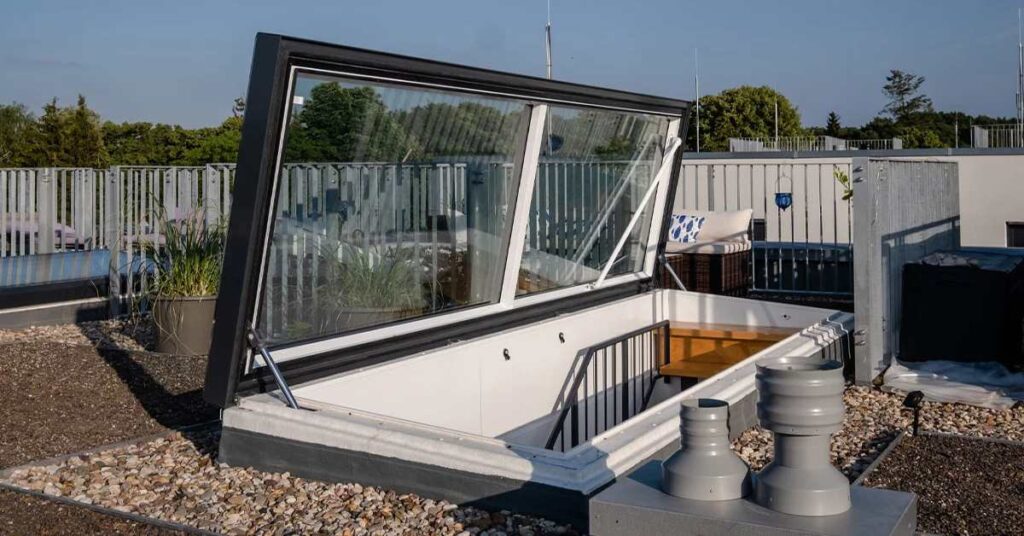In architecture and interior design, each component plays a vital role in shaping a structure’s overall performance. An often-neglected factor that potentially influences a building’s functionality is the selection of access doors, especially those on flat roofs.
Flat roof access doors not only enhance accessibility but also contribute to the aesthetic appeal and efficiency of a design. In this blog, we’ll explore how these doors can elevate your roof’s performance, offering architects and interior designers a valuable tool to enhance their projects.
- Enhanced Accessibility: Flat roof access doors like the Fakro DRL flat roof access doors play a pivotal role in improving the accessibility of rooftop areas. Architects can strategically incorporate these doors into their designs, providing a seamless and secure means of access for maintenance, inspections, and repairs.
This deliberate integration encourages a proactive approach to building management—minimizing downtimeand lowering overall maintenance costs. The convenience afforded by these doors ensures that essential tasks on the roof are executed efficiently, contributing to the overall functionality of the structure.
- Seamless Integration: One of the best features of flat roof access doors is their ability to integrate seamlessly into the overall architectural design. Architects and interior designers can select from a diverse range of materials, finishes, and styles, ensuring that the access doors harmonize with the aesthetic of the entire structure.
This integration not only elevates the visual appeal of the building but also fosters a cohesive design language throughout, contributing to a unified and aesthetically pleasing architectural composition.
- Optimized Space Utilization: Flat roof access doors facilitate optimized space utilization, allowing architects to make the most of available square footage. By strategically positioning these doors, designers can create functional rooftop areas for dual purposes, such as outdoor lounges, gardens, or recreational spaces.
This innovative use of space adds significant value to the building, enhancing its utility and appeal. Incorporating flat roof access doors thus becomes a strategic design choice that maximizes the potential of the available space.
- Energy Efficiency: The integration of flat roof access doors with advanced insulation features becomes a key contributor to improved energy efficiency. When properly sealed, theyhelp prevent air leakage, maintaining a consistent indoor temperature.
These access doors reduce the load on HVAC systems, aligning with sustainable design principles. Architects can opt for doors with high thermal resistance, actively contributing to the building’s overall energy performance and demonstrating a commitment to environmentally conscious design.
- Natural Light and Ventilation: Architects can leverage flat roof access doors to introduce natural light and ventilation into interior spaces. Through strategic placement, designers can create well-lit and ventilated areas, diminishing the reliance on artificial lighting and mechanical ventilation systems.
This enhances energy efficiency and fosters a more comfortable living or working space. Incorporating flat roof access doors becomes a deliberate strategy for architects aiming to create spaces prioritizing occupants’ well-being.
- Safety and Security: Flat roof access doors are designed with paramount consideration for safety and security. Architects can select doors equipped with robust locking mechanisms to ensure that rooftop areas remain secure from unauthorized access.
Features such as non-slip surfaces and solid construction further contribute to the overall safety of maintenance personnel accessing the roof. The deliberate emphasis on safety makes flat roof access doors integral in creating secure and functional building environments.
- Compliance with Regulations: Architects must adhere to building codes and regulations, and flat roof access doors provide a solution for meeting accessibility requirements and safety standards.
By incorporating these doors into their designs, architects ensure their projects align with relevant regulations, mitigating potential legal issues and avoiding construction delays. Including flat roof access doors becomes a design choice and a strategic decision to navigate and adhere to the complex landscape of building regulations.
Related Articles:
The Vital Importance of Removable Plastic Access Doors in a Living Room
Tips for Beautifying Your Home
Conclusion
Every detail holds significance in the intricate realm of architecture and interior design, and flat roof access doors emerge as a versatile tool for architects and interior designers. These doors contribute to the structure’s functionality, accessibility, and aesthetic appeal.
From optimizing space to promoting energy efficiency, flat roof access doors play a pivotal role in shaping modern buildings’ roof performance. By considering these doors as integral components of their designs, architects elevate the overall quality and longevity of their projects, ensuring a harmonious coexistence of form and function in the built environment.






